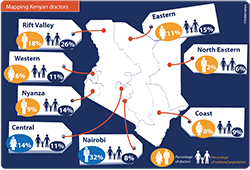Big Data and Communicating Public Health
 “Big data” has the potential to revolutionize the healthcare industry. By identifying the most effective treatments for diseases, evaluating efficiency of digital records and matching treatments to a patient’s specific biology, big data can be used to answer a basic but important question: Why, after billions of dollars in government and aid funding, are people still so sick in many parts of the world? In Kenya, the media is increasingly using big data through data journalism to help people understand the data behind health failures, to empower citizens to demand better policies and solutions.
“Big data” has the potential to revolutionize the healthcare industry. By identifying the most effective treatments for diseases, evaluating efficiency of digital records and matching treatments to a patient’s specific biology, big data can be used to answer a basic but important question: Why, after billions of dollars in government and aid funding, are people still so sick in many parts of the world? In Kenya, the media is increasingly using big data through data journalism to help people understand the data behind health failures, to empower citizens to demand better policies and solutions.
Kenya is a good case study when it comes to big data, the media and health-related social and behavior change communication (SBCC). It is in the process of rolling out its system of devolving power from central government to the 47 counties that make up the county. As the process unfolds, a key question in addressing pressing needs of citizens is whether counties with significantly higher health problems will spend more money on health.
An investigation by Paul Wafulu, a journalist for The Standard in Kenya, revealed a straight-forward finding: most counties were budgeting less on health than they had been allocated the year before by the national government, even if their population was sicker and had fewer health facilities and personnel than average. Such stories help the public put their personal health struggles in perspective and democratize health spending decisions, by giving them the information they need to push for specific policies from their leaders, as well as hold those in power to account.
The Politics of Health project ahead of the March 2013 presidential elections in Kenya also used data to ensure accountability, in this instance, promises to deliver universal healthcare. By using data, the media was able to show that there simply isn’t enough money, doctors, nurses or facilities for universal healthcare. However, it was an important step in driving the conversation to achievable health goals based on actual resources and realistic targets.
Internews in Kenya developed the Internews Data Dredger to offer those engaged in public health advocacy and the media, simple, digestible data visualizations about the most pressing health issues in their community, such as maternal deaths, malnutrition, and infection diseases. These are issues that the mass media would cover in any event, as they relate to stories that are of interest to the public. But now, instead of a story of one pre-mature baby dying in her mother’s arms in the hospital, the story becomes about a region-wide shortage of incubators and how simple techniques can help premature babies survive.
In Kenya, data has also liberated the media from the highly politicized topic of abortion to focus on the health of women. Abortion in the Age of Birth Control by Mercy Juma explores the link between unsafe abortions and a lack of access to contraceptives, while The Cost of Unsafe Abortions by Samuel Otieno looks at the long-term financial impact of fixing botched illegal abortions. By removing the politics from the equation and replacing it with evidence-based information gleaned from available data, journalists were able to identify practical solutions to improving women’s health.
By publishing big data on platforms, accessible to the public, for the first time in Kenya, citizens can compare the amount their counties spend on healthcare to their neighbors healthcare spending. Based on an economic model, they can also check how much the government should be spending. Audiences link this information to that of public health campaigns, and stories that speak to the individual impact of health policies and decision. In the end, it isn’t about data, but about how data impact people – a key factor understood by journalists worldwide.








Leave a Reply
Want to join the discussion?Feel free to contribute!